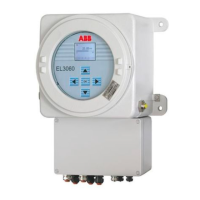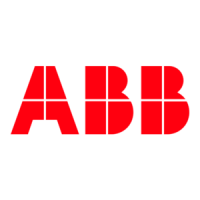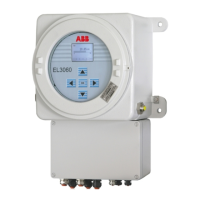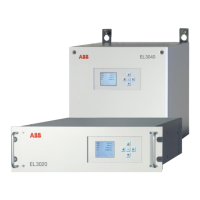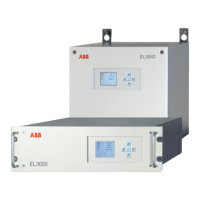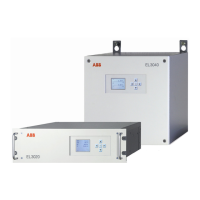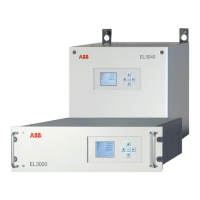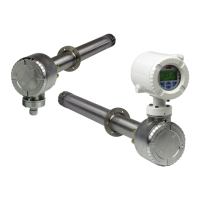Do you have a question about the ABB EL3060-Uras26 and is the answer not in the manual?
Lists the sequential steps for installation and commissioning of the gas analyzer.
Describes the intended application and limitations of the gas analyzer.
Highlights crucial safety parameters and conditions for hazardous areas.
Covers safe operation, qualified personnel, observed instructions, regulations, device safety, and equipotential bonding.
Details on working in hazardous areas, complying with regulations, and prohibiting work with explosion hazards.
Covers installation according to IEC/EN 60079-14, equipotential bonding, and electrostatic charging.
Defines customer's role in ensuring secure network connections and data protection.
Lists ATEX and IECEx certification details for analyzer units.
Discusses suitability for flammable/non-flammable gases and oxygen limits.
Covers temperature, inlet pressure, flow rate, and outlet pressure.
Describes suitability for positive pressure with flammable/non-flammable gases.
Specifies temperature, pressure, and flow rate limits for Magnos/Caldo s analyzers.
Specifies temperature, pressure, and flow rate limits for the Uras26 analyzer.
Explains recommended seal integrity checks before commissioning and procedures.
Covers safety regulations, equipotential bonding, and risks of disconnection.
Diagram showing terminal assignments for digital inputs, outputs, analog, data, Ethernet, and power.
Provides a checklist for verifying correct installation before operation.
Checks for intact housings, flame barriers, O-rings, and securely fastened components.
Details the requirement and method for initial purging to remove explosive mixtures.
Steps for switching on power, boot process, warm-up phase, and configuration check.
Table detailing functions, their availability on Device, Configurator, and Modbus.
Describes Ethernet communication for software, QAL3 data, and Modbus TCP/IP.
Steps to establish communication between analyzer and computer, including parameter checks.
Details parameters for DHCP settings, network names, and IP address configuration.
Guide for configuring computer IP and testing the Ethernet link using 'ping'.
How to start communication, receive, send, and save configuration data.
Overview of manual/auto calibration, status signals, and analog output behavior.
Defines set points for zero-point and end-point calibration for manual/auto calibration.
Methods to start auto-calibration (time, external, manual) and how to disable it.
Parameters for auto-calibration set via configurator or directly on the instrument.
Enabling auto-calibration, setting cycle time, and scheduling next calibration.
Steps for performing zero-point calibration.
Steps for performing end-point calibration.
Steps for Uras26 end-point calibration using calibration cells.
Describes auto, manual, substitute gas, and single-point calibration for Magnos206.
Describes auto, manual, substitute gas, and single-point calibration for Magnos28.
Describes auto, manual, and substitute gas calibration for Caldos25.
Details limits and rules for combining measuring ranges.
Ways to execute range switch-over and implement feedback signals.
Configuring range limits and switch-over thresholds using the ECT software.
Setting mode, limits, and autorange thresholds directly on the analyzer.
Notes and procedure for setting range limits for Uras26.
Notes and procedure for setting range limits for Magnos206.
Notes and procedure for setting range limits for Magnos28.
Notes and procedure for setting range limits for Caldos27.
Details parameters for setting alarm limits: active, component, value, direction, hysteresis, delay, confirmation.
Parameters for non-linear filter: time constants and switching threshold.
How to switch active components externally via digital inputs/outputs.
How to change measurement units (ppm, vol%, etc.) using ECT.
Steps for selecting or deleting sample components in the configurator and analyzer.
Describes configuration of analog outputs, digital outputs, and digital inputs.
Explains Ethernet communication for software, QAL3 data, and Modbus TCP/IP.
Details DHCP settings, network names, IP addresses, and MAC address.
Steps to upload a new language file using the ECT software tool.
Steps for receiving data, and sending the language file.
Selecting the desired language file and transferring it to the analyzer.
Explains password protection for calibration and configuration menus.
Procedure for setting a new password via the configurator.
Steps to update the analyzer's software using the ECT tool.
Steps for receiving data, saving configuration, and initiating software update.
Confirming overwrite, uploading new software, and rebooting the analyzer.
Explains QAL3 monitoring for AMS quality assurance and its characteristics.
Lists requirements for operating QAL3 monitoring (PC connection, browser, option).
Details performance characteristics and tests for precision and drift using CUSUM charts.
Explains how Shewhart charts determine precision and drift, and identify 'Out of Control' status.
Setting parameters for individual sample components in QAL3 monitoring.
Lists the sequential steps for installation and commissioning of the gas analyzer.
Describes the intended application and limitations of the gas analyzer.
Highlights crucial safety parameters and conditions for hazardous areas.
Covers safe operation, qualified personnel, observed instructions, regulations, device safety, and equipotential bonding.
Details on working in hazardous areas, complying with regulations, and prohibiting work with explosion hazards.
Covers installation according to IEC/EN 60079-14, equipotential bonding, and electrostatic charging.
Defines customer's role in ensuring secure network connections and data protection.
Lists ATEX and IECEx certification details for analyzer units.
Discusses suitability for flammable/non-flammable gases and oxygen limits.
Covers temperature, inlet pressure, flow rate, and outlet pressure.
Describes suitability for positive pressure with flammable/non-flammable gases.
Specifies temperature, pressure, and flow rate limits for Magnos/Caldo s analyzers.
Specifies temperature, pressure, and flow rate limits for the Uras26 analyzer.
Explains recommended seal integrity checks before commissioning and procedures.
Covers safety regulations, equipotential bonding, and risks of disconnection.
Diagram showing terminal assignments for digital inputs, outputs, analog, data, Ethernet, and power.
Provides a checklist for verifying correct installation before operation.
Checks for intact housings, flame barriers, O-rings, and securely fastened components.
Details the requirement and method for initial purging to remove explosive mixtures.
Steps for switching on power, boot process, warm-up phase, and configuration check.
Table detailing functions, their availability on Device, Configurator, and Modbus.
Describes Ethernet communication for software, QAL3 data, and Modbus TCP/IP.
Steps to establish communication between analyzer and computer, including parameter checks.
Details parameters for DHCP settings, network names, and IP address configuration.
Guide for configuring computer IP and testing the Ethernet link using 'ping'.
How to start communication, receive, send, and save configuration data.
Overview of manual/auto calibration, status signals, and analog output behavior.
Defines set points for zero-point and end-point calibration for manual/auto calibration.
Methods to start auto-calibration (time, external, manual) and how to disable it.
Parameters for auto-calibration set via configurator or directly on the instrument.
Enabling auto-calibration, setting cycle time, and scheduling next calibration.
Steps for performing zero-point calibration.
Steps for performing end-point calibration.
Steps for Uras26 end-point calibration using calibration cells.
Describes auto, manual, substitute gas, and single-point calibration for Magnos206.
Describes auto, manual, substitute gas, and single-point calibration for Magnos28.
Describes auto, manual, and substitute gas calibration for Caldos25.
Details limits and rules for combining measuring ranges.
Ways to execute range switch-over and implement feedback signals.
Configuring range limits and switch-over thresholds using the ECT software.
Setting mode, limits, and autorange thresholds directly on the analyzer.
Notes and procedure for setting range limits for Uras26.
Notes and procedure for setting range limits for Magnos206.
Notes and procedure for setting range limits for Magnos28.
Notes and procedure for setting range limits for Caldos27.
Details parameters for setting alarm limits: active, component, value, direction, hysteresis, delay, confirmation.
Parameters for non-linear filter: time constants and switching threshold.
How to switch active components externally via digital inputs/outputs.
How to change measurement units (ppm, vol%, etc.) using ECT.
Steps for selecting or deleting sample components in the configurator and analyzer.
Describes configuration of analog outputs, digital outputs, and digital inputs.
Explains Ethernet communication for software, QAL3 data, and Modbus TCP/IP.
Details DHCP settings, network names, IP addresses, and MAC address.
Steps to upload a new language file using the ECT software tool.
Steps for receiving data, and sending the language file.
Selecting the desired language file and transferring it to the analyzer.
Explains password protection for calibration and configuration menus.
Procedure for setting a new password via the configurator.
Steps to update the analyzer's software using the ECT tool.
Steps for receiving data, saving configuration, and initiating software update.
Confirming overwrite, uploading new software, and rebooting the analyzer.
Explains QAL3 monitoring for AMS quality assurance and its characteristics.
Lists requirements for operating QAL3 monitoring (PC connection, browser, option).
Details performance characteristics and tests for precision and drift using CUSUM charts.
Explains how Shewhart charts determine precision and drift, and identify 'Out of Control' status.
Setting parameters for individual sample components in QAL3 monitoring.
| Brand | ABB |
|---|---|
| Model | EL3060-Uras26 |
| Category | Measuring Instruments |
| Language | English |
